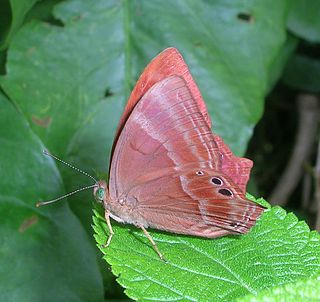
Abisara echerius, the plum Judy, is a small but striking butterfly found in Asia belonging to the Punches and Judies family (Riodinidae). It is difficult to distinguish it from Abisara bifasciata.
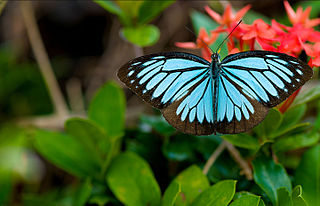
Pareronia valeria, the common wanderer or Malayan wanderer, is a medium-sized butterfly of the family Pieridae, that is, the yellows and whites, and is found in India and Southeast Asia. The butterfly found in India is sometimes considered as a separate species, Pareronia hippia.

Meandrusa sciron, the brown gorgon, is a species of swallowtail butterfly found in parts of South Asia and Southeast Asia. It belongs to the hooked swallowtails genus, Meandrusa, of the family Papilionidae. The brown gorgon is found in India from Sikkim to Assam and north Burma and is not considered to be threatened. Though not uncommon, it is protected under Indian law under the name gyas.

Dodona dipoea, the lesser Punch, is a small but striking butterfly found in the Indomalayan realm that belongs to the Punches and Judies, that is, the family Riodinidae.
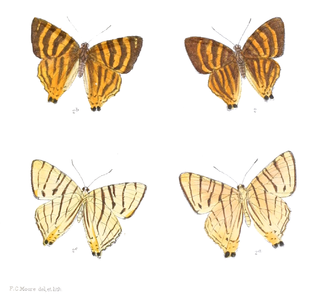
Dodona adonira, the striped Punch, is a small but striking butterfly found in the Indomalayan realm that belongs to the Punches and Judies, that is, the family Riodinidae.

Libythea lepita, the common beak, is a butterfly that belongs to the Libytheinae group of the brush-footed butterflies family. It is found from southern India to Japan and its larval food plants include members of the Cannabaceae, particularly in the genera Celtis and Trema.
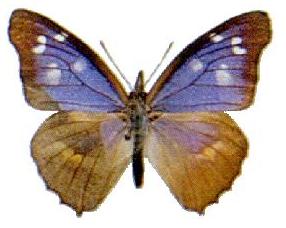
Libythea geoffroy, the purple beak, is a butterfly found in parts of India and Myanmar that belongs to the subfamily Libytheinae of the family Nymphalidae.
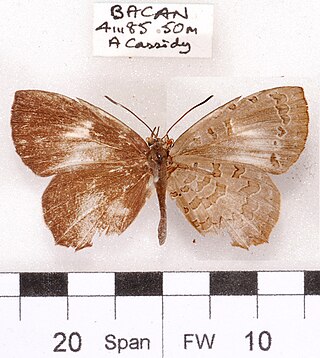
Miletus boisduvali, the common brownie, is a small but striking butterfly found in India and Myanmar that belongs to the lycaenids or blues family.

Miletus symethus, the great brownie, is a small butterfly found in India that belongs to the lycaenids or blues family. The species was first described by Pieter Cramer in 1777.
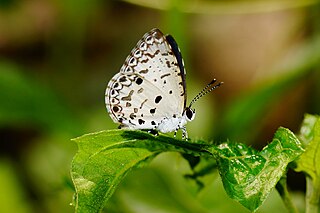
Megisba malaya, the Malayan, is a small species of butterfly found in South Asia and Southeast Asia. It belongs to the family of gossamer-winged butterflies (Lycaenidae). The species was first described by Thomas Horsfield in 1928.

Acytolepis puspa, the common hedge blue, is a small butterfly found in Cambodia, India, Myanmar, Thailand, Malaysia, Singapur, Yunnan, Taiwan, Sri Lanka, Philippines, Borneo and New Guinea that belongs to the lycaenids or blues family. The species was first described by Thomas Horsfield in 1828.

Prosotas noreia, the white-tipped lineblue, is a species of lycaenid butterfly found in South Asia and Java.

Nacaduba berenice, the rounded six-line blue, is a lycaenid butterfly found in Indomalayan realm. The species was first described by Gottlieb August Wilhelm Herrich-Schäffer in 1869.

The Indian fritillary is a species of butterfly of the nymphalid or brush-footed family. It is usually found from south and southeast Asia to Australia.

Faunis arcesilaus, the Indian faun is a butterfly found in South Asia that belongs to the Morphinae subfamily of the brush-footed butterfly family.

Amathuxidia amythaon, the koh-i-noor, is a butterfly found in Asia. It belongs to the Morphinae, a subfamily of the brush-footed butterflies.

Stichophthalma camadeva, the northern jungle queen, is a butterfly found in South Asia that belongs to the Morphinae subfamily of the brush-footed butterflies family.

Stichophthalma nourmahal, is a South Asian butterfly that belongs to the Morphinae subfamily of the brush-footed butterflies family.

Stichophthalma sparta, the Manipur jungle queen, is a butterfly found in South Asia that belongs to the Morphinae subfamily of the brush-footed butterflies family.
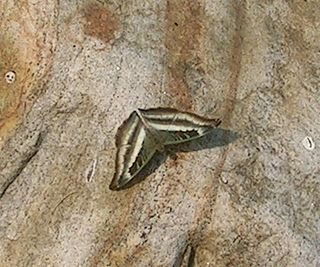
Auzakia is a monotypic butterfly genus in the family Nymphalidae. It contains the single species, Auzakia danava, the commodore, which is found from Tibet to Sumatra.




















